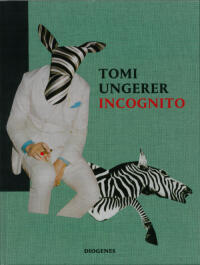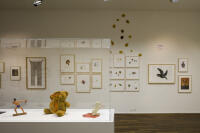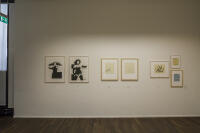Tomi Ungerer. INCOGNITO
30.10.2015 – 07.02.2016
Curated by Cathérine Hug.
Curated by Cathérine Hug.
Provocateur, Erotomaniac, Cosmopolitan, Storyteller: Tomi Ungerer
The exhibition curated by Cathérine Hug cast a fresh eye on the polyglot Alsatian Jean-Thomas ‘Tomi’ Ungerer (b. 1931 Strassburg, d. 2019 Cork), known as an illustrator, cartoonist, graphic artist, and author of children’s books. On display were 160 previously rarely seen social-critical collages as well as drawings and sculptures from about 60 years. Although Ungerer’s collages are normally not so easy to categorize, the erotic gaze as a man of the world, which is rather irritating from today’s point of view, is clear: In the collage Untitled from 2013, the open mouth of a muscular male swimmer is approaching a naked woman lying with her legs spread on an air mattress. Journey’s Last Leg (2005) is more ambivalent: A man with an amputated leg is limping through a bombed city past three female legs pointing up to the sky (2005). Ungerer’s erotic works (such as drawings for the publication Fornicon from 1971, banned for decades in the USA) still caused a scandal in 1981, when the retrospective was touring Europe.
Ungerer was formed by his origins in the embattled Alsace, torn culturally back and forth between France and Germany, which opened his mind to questions of identity and the ‘neither/nor;’ later he was to call himself a ‘Chameleonist.’ In the 1950s Ungerer emigrated to New York. The creative center of the postwar world is often also called ‘collage city’ (see the architecture theorist Colin Rowe), and collage was the medium acquired by Ungerer with great virtuosity. Although a traditional medium, collage made it possible to break away from a certain strictness and established order, making it suitable for artists, especially in the postwar years. The deconstruction of what existed provided a feeling of personal empowerment and assembling something new from old materials enabled intellectual bite with little effort.
Ungerer was seen relatively seldom in art museums; with this monographic exhibition, later shown in the Museum Folkwang Essen, the Kunsthaus Zurich performed pioneer work – doing so just a few years before Ungerer’s death. The main lenders were the artist himself, who also contributed to the selection of works, the Musée Tomi Ungerer – Centre international de l’illustration (Strasbourg) and the Würth Collection (Künzelsau). The widely acknowledged exhibition was accompanied with a publication of 400 pages from the Diogenes-Verlag with readable written contributions in three languages.
[Peter Stohler]
Although a traditional medium, collage made it possible to break away from a certain strictness and established order, making it suitable for artists, especially in the postwar years. The deconstruction of what existed provided a feeling of personal empowerment and assembling something new from old materials enabled intellectual bite with little effort.
100 days
1 Artist
1 Artist

1/9
exhibition catalog

2/9
exhibition poster

3/9
exhibition view

4/9
exhibition view

5/9
exhibition view

6/9
exhibition view

7/9
exhibition view

8/9
exhibition view

9/9
exhibition view
1/9